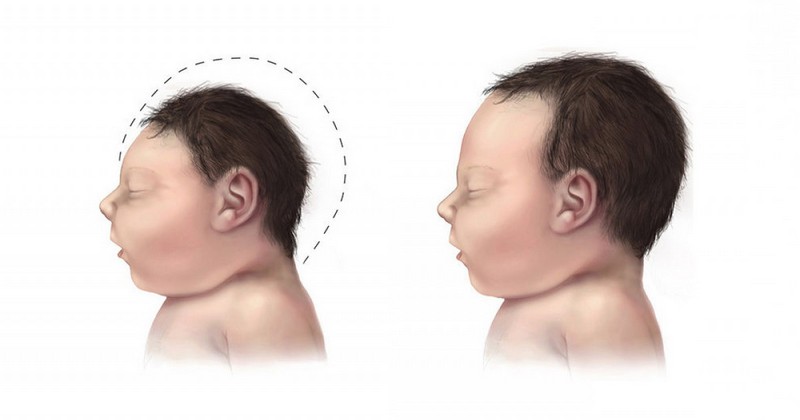Microcephaly: symptoms, characteristics and treatment

This alteration in babies occurs when the skull or brain does not grow enough.
The nervous system is one of the first systems of our organism to begin to develop during gestation. Throughout pregnancy and even throughout an individual's life, this system will be modified and developed, especially from gestation to early adulthood.
However, in some cases the brain does not grow as it should or as fast as usual from pregnancy, causing the birth of children with heads of a much smaller perimeter than average, often linked to the presence of various disorders and a certain degree of intellectual disability. This is known as microcephaly..
Microcephaly: concept and symptoms
Microcephaly is understood as the situation, condition or neonatal affectation in which the child's skull and brain show an evident absence or delay of development at birth or during the first years, in comparison at birth or during the first years, compared to other individuals of the same age. It is a rare disorder that may be due to different causes. In general, the head circumference of a child with microcephaly is considered to be between two and three standard deviations below the average.
Although in some cases children with microcephaly may have a normative level of intelligence, as a general rule this condition is associated with a variable degree of intellectual disability. with a variable degree of intellectual disability. Various disorders such as vision loss, feeding difficulties, generalized slowing of development and seizures may also occur.
With the passage of time and as the child grows, the face and the rest of the body develop, but the skull has not yet grown. the skull still does not grow. That is why this type of infants usually have a sunken forehead and an elongated face.
Generally this situation is detected during pregnancyor within the first hours after birth. However, sometimes it can take years before an atypical development is identified, not being evident in the first months of life.
Origin of this type of medical condition
There is not a single cause that can generate microcephaly, but we can find different disorders and conditions that can generate it. different disorders and conditions that can generate it. Most of them are conditions and diseases that occur or are transmitted throughout the development of the fetus or during childbirth.
Some genetic disorders, mutations and alterations can cause microcephaly. Among them, trisomies 18 (Edwards' syndrome) and 21 (Down syndrome) stand out.
Other of the most frequent causes of microcephaly have to do with the transmission of various viruses from the mother to the fetus.. Toxoplasmosis, cytomegalovirus, rubella or the well-known Zika virus have been shown to cause alterations in the fetus that can lead to microcephaly.
In addition to this, pregnant women should take care of their health and treat diseases such as phenylketonitis, pneumococcal disease diseases such as phenylketonuria or Diabetes (which, if not controlled (which if not controlled can also alter the development of the fetus due to the absence of certain nutrients). Some drugs and the abusive use of alcohol can also cause this alteration. Malnutrition also makes it difficult for the future child to develop normally.
Complications during delivery
Even if fetal development is adequately completed, complications such as anoxia may arise during delivery that can alter the functioning and developmental capacity of the brain.
Also, although the size of the skull generally increases as the brain grows, with the size of the latter causing the former to be smaller in cases of microcephaly, there are cases of premature suturing of the skull bones that prevent the brain from growing, a medical condition known as craniosynostosis..
Treatment
Microcephaly has no treatment to reverse the condition. The treatments that are performed are based on occupational therapy, stimulation and educational practice. It is necessary and very useful to offer therapies focused on speech and psychomotor skills so that these children improve their basic skills, as well as working on their emotional sphere. The aim is to ensure that they can lead the best possible life by optimizing their skills and exploiting their potential.
Likewise, psychoeducation and counseling to the family and the close environment is fundamental is essential so that they can help the child to develop in the most adaptive way possible, while providing information and allowing the family to express their doubts and fears.
One of the conditions that can cause microcephaly is the premature hardening of the bony plates of the skull or craniosynostosis, which prevents the normal growth and development of the brain by physically limiting it. This particular condition, if detected early, can be reversed by surgery, can be reversed by surgeryThis would avoid harmful effects on the brain.
Prevention is also essential. The consumption of drugs and certain substances by the mother, malnutrition, the non-treatment of medical conditions such as phenylketonuria or the transmission of certain viruses such as toxoplasmosis (which can be transmitted through cat feces or the consumption of uncooked, spoiled or contaminated food) can be possible causes of the appearance of microcephaly, and in some cases can be avoided.
Bibliographic references:
- Kinsman ,S.L. & Johnston, M.V. (2016). Congenital anomalies of the central nervous system. In: Kliegman RM, Stanton BF, St Geme JW, Schor NF, eds. Nelson Textbook of Pediatrics. 20th ed. Philadelphia, PA: Elsevier.
(Updated at Apr 14 / 2024)